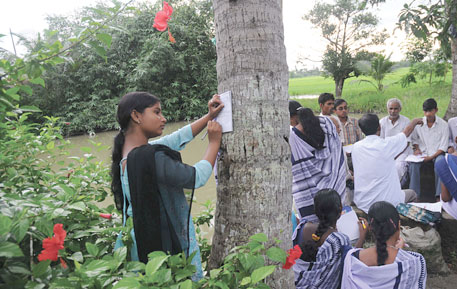Article and Image Courtesy : Down to Earth
Author : Sayantan Bera
 Schoolchildren in Sundarbans jot down what village elders say about lost and disappearing plants and animals
Schoolchildren in Sundarbans jot down what village elders say about lost and disappearing plants and animals
Worlds can change within minutes, or kilometres. It was the bumpy six-hour ride from Kolkata to a tiger reserve in the largest riverine delta in the world, that told me this. Hopping islands in the Sundarbans onboard Rs 1 ferry rides, on rickety cycle vans dancing on puddles, and walking on slippery brick ways, the arduous journey is not for the big cat though. I am to witness the beginning of a stupendous task: documentation of life in its myriad hues.
The task attempts the rigorousness of serious anthropology by schoolchildren, some as young as 13. During this simulation exercise the students are to assimilate knowledge of generations on plants growing unrestrained and cultivated, and on animals wild and domesticated. Outside the Rajat Jubilee High School is a motley crowd of 15 students from two local schools speaking to village elders. The school is on the 20,000-hectare Satjelia Island, a part of the Sundarbans delta that crisscrosses India and Bangladesh.
About a week ago, senior researchers from the West Bengal Biodiversity Board (WBBB) had organised a workshop to explain to these students the need to document local flora and fauna. They explained how traditional knowledge of the lost varieties of plants and animals could be gathered from village elders.
Sitting close to a pond, 71-year-old Binay Mandal starts a story. “Our land has lost more than 60 local varieties of rice, including patnai, rupsal, gopalbhog, chinikari, koibhuri, kumrabori,” he wants to go on, but 17-year-old Prasenjit Mandal interrupts, “We have other varieties now, so why are the local ones important?”
“After Aila hit the Sundarbans,” explains the 71-year-old, “we could not grow rice for two years. Salty water from the river invaded the fields and the high-yielding varieties failed. Many of our traditional varieties were tolerant to salinity.” The super cyclone that hit West Bengal and Bangladesh in 2009 had brought telling miseries to people.
The discussion starts to ramble, but Binay returns to rice cultivation. “Use of pesticides to cultivate high-yielding varieties has poisoned the water. Local fish which thrived in the submerged paddy fields and ponds have declined in number. How many of you have seen the nyadosh fish? When caught it would pretend to be dead and not move at all,” he says. No wonder it is called nyadosh, colloquial Bengali for stupid. “Today many delicate varieties have disappeared due to use of pesticides. With the fish gone, the birds and earthworms which thrived on them have also declined,” he says.
The exercise in making inventories soon began to find ways to conserve lost species and revive the rare ones. “We can try to bring back some of the traditional varieties of rice. Ranjit Barman has cultivated ghayus this year, Padma Mandal is cultivating jhingasal. We have to preserve the seeds from them,” Binay pauses, while the schoolchildren busily scribble in their notebooks.